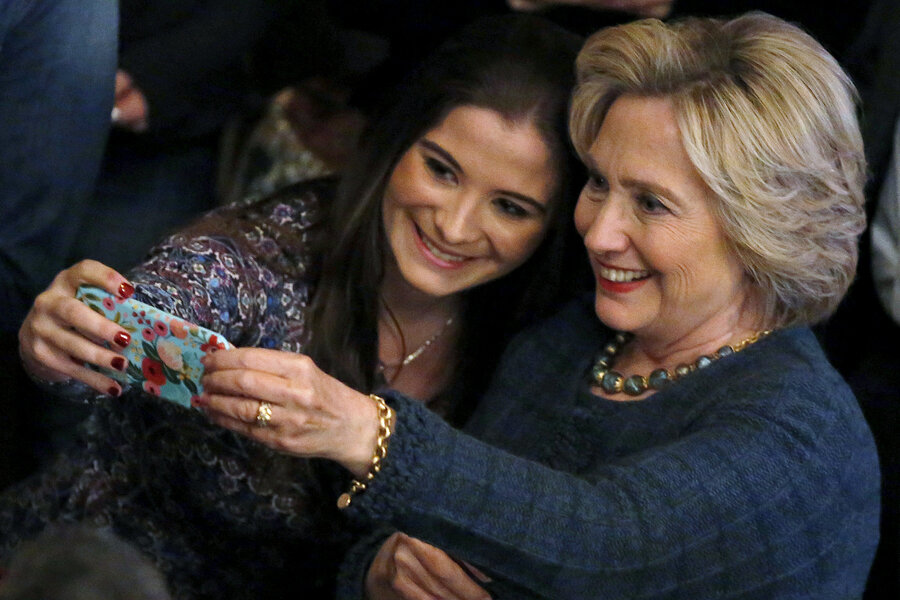The tyranny – and opportunity – of a 'selfie' election
Loading...
In 1788, founding father James Madison famously warned against the tyranny of the majority, a fear that decisions and laws made by a majority may leave out or oppress minorities.
Today, Hillary Clinton is concerned about a different kind of tyranny – "The tyranny of the selfie."
"It used to be — and I was talking to President Obama about this the other day — it used to be that you would do an event like this and then you would shake hands with people and they would talk to you," Mrs. Clinton told Esquire magazine in a recent interview. "They would say, 'I liked what you said about this' or 'You didn't mention that' or 'Can I tell you this?' And it was a constant learning and absorbing experience."
"Now," Clinton added, "it's just 'Can I take a selfie? Can I take a picture?' People just want to capture that moment, and I just try to be accommodating."
How, exactly, is the "selfie election" impacting voter interaction? As more voters focus on grabbing Facebook- and Instagram-worthy shots, is more substantive interaction suffering, as Clinton suggests? Are candidates getting a chance to actually connect and converse with voters, or just posing for vanity shots?
Some candidates and their campaigns are concerned, or at least appear frustrated, by this social-media-centric practice.
Last month, Jeb Bush called selfies "the 11th Amendment of the Bill of Rights."
"I don't know, look, it wasn't that long ago that people wanted signatures on things, and now, forget that, 'I want my damn selfie. I'm not leaving until I get it,'" Bush told a crowd of Florida supporters in December. So we spend a lot of quality time doing that," Bush added.
In an April 2015 op-ed for The Washington Post, Ben Carson slammed selfies as narcissistic and dangerous.
"Please stop," Dr. Carson wrote. “Beyond the obvious narcissism of endlessly photographing oneself and blasting it over social networks for others to admire, selfies are dangerous,” he went on, citing examples of how some selfie snappers had died.
Before smartphone technology gave rise to selfie culture, politicians would shake hands with supporters after events, maybe even sign an autograph, and get useful feedback on what voters were thinking.
Some politicians – like Bill Clinton – were known for connecting with folks on the rope line and turning that feedback into actionable ideas.
Today, many supporters line up just to get a selfie. Kentucky Sen. Rand Paul has been known to spend two hours satisfying lines of selfie seekers, and Texas Sen. Ted Cruz adds 20 minutes to his schedule before and after events to do selfies, reports the The New York Times, which is calling it "the must-have political souvenir of 2016."
"It is certainly the case that overuse of technology can have detrimental effects on human interaction, which is likely what Clinton is railing against," says Denise Friedman, associate professor of psychology at Roanoke College in Salem, Va.
At least one study suggests that selfies do damage relationships.
“Increased frequency of sharing photographs of the self, regardless of the type of target sharing the photographs, is related to a decrease in intimacy,” a joint study conducted by the University of Birmingham, the University of Edinburgh, and Heriot-Watt University, concluded in 2013. In other words, selfies can lead to more shallow relationships.
But evidence suggests selfies may not be that bad.
“Psychologically speaking, there may be some benefit to participating in sharing selfies because this practice is interwoven in our social culture and is a way to interact socially with others," Andrea Letamendi, a clinical psychologist and research fellow at UCLA, told Time magazine.
Some campaigns have even leveraged the phenomenon to their benefit. Aides for Senator Paul often hold up a Paul-branded backdrop when he poses for selfies. And when those selfies are shared on Facebook or Instagram or Twitter, they work to increase a candidate's visibility and the chatter around an event.
“This is something that campaigns should embrace and be very happy with, because it’s just free advertising,” Paul’s chief digital strategist, Vincent Harris, told the Times.
Perhaps more importantly, if they're interested in getting votes, Professor Friedman says, candidates should worry less about interaction and more about how they're presenting themselves to voters.
"Political candidates should consider carefully how they present themselves on social media as young adults are watching them to see whether they can identify with the candidate ... Young adults were more likely to report they would vote for a candidate than "like" them on Facebook if they perceived similarities. As candidates care about getting out the vote, they – or their campaign managers – should consider this when interacting with voters."
In other words, the next time a potential supporter asks for a selfie, Clinton – or Bush, or Carson – should grin and bear it.








